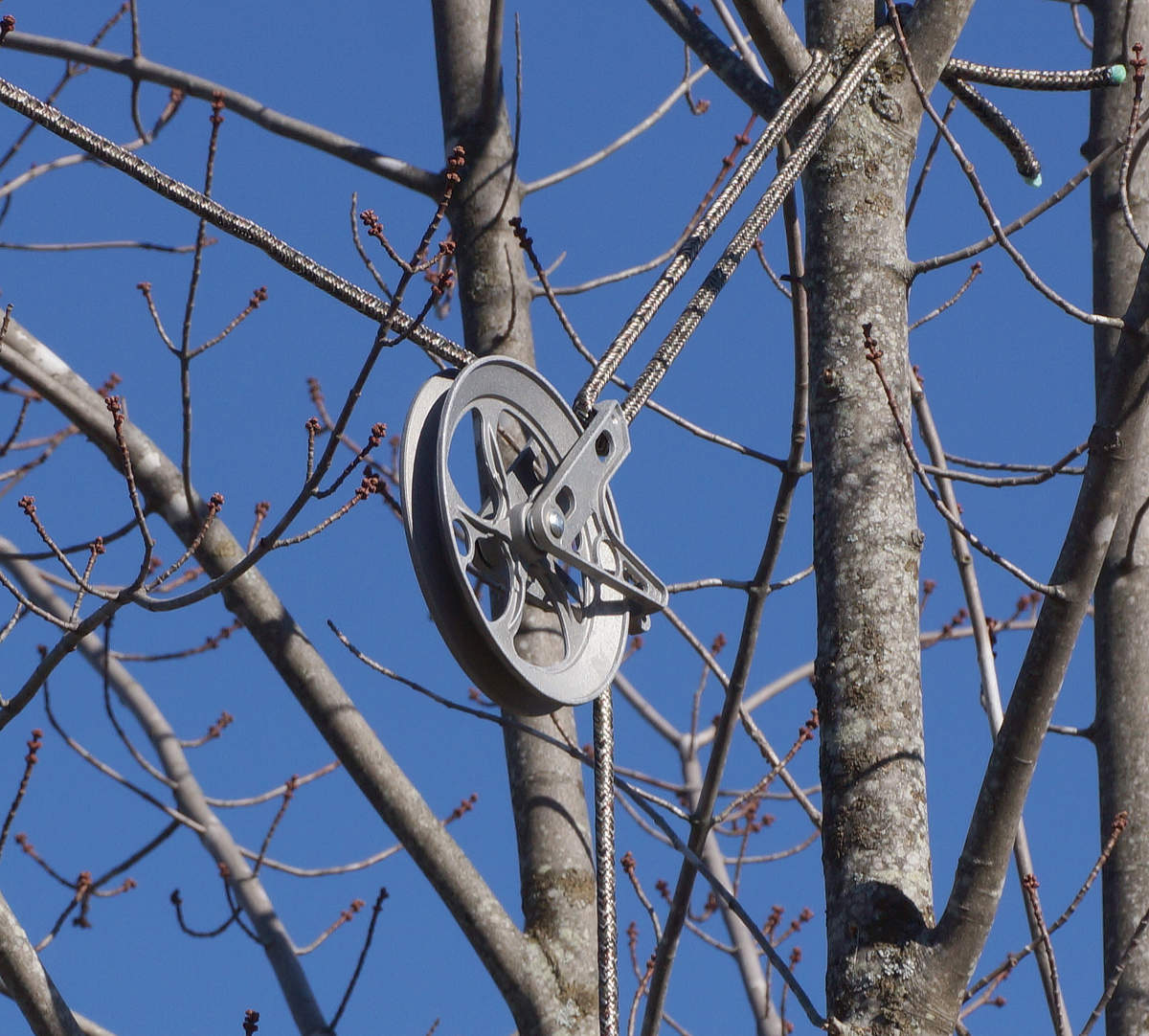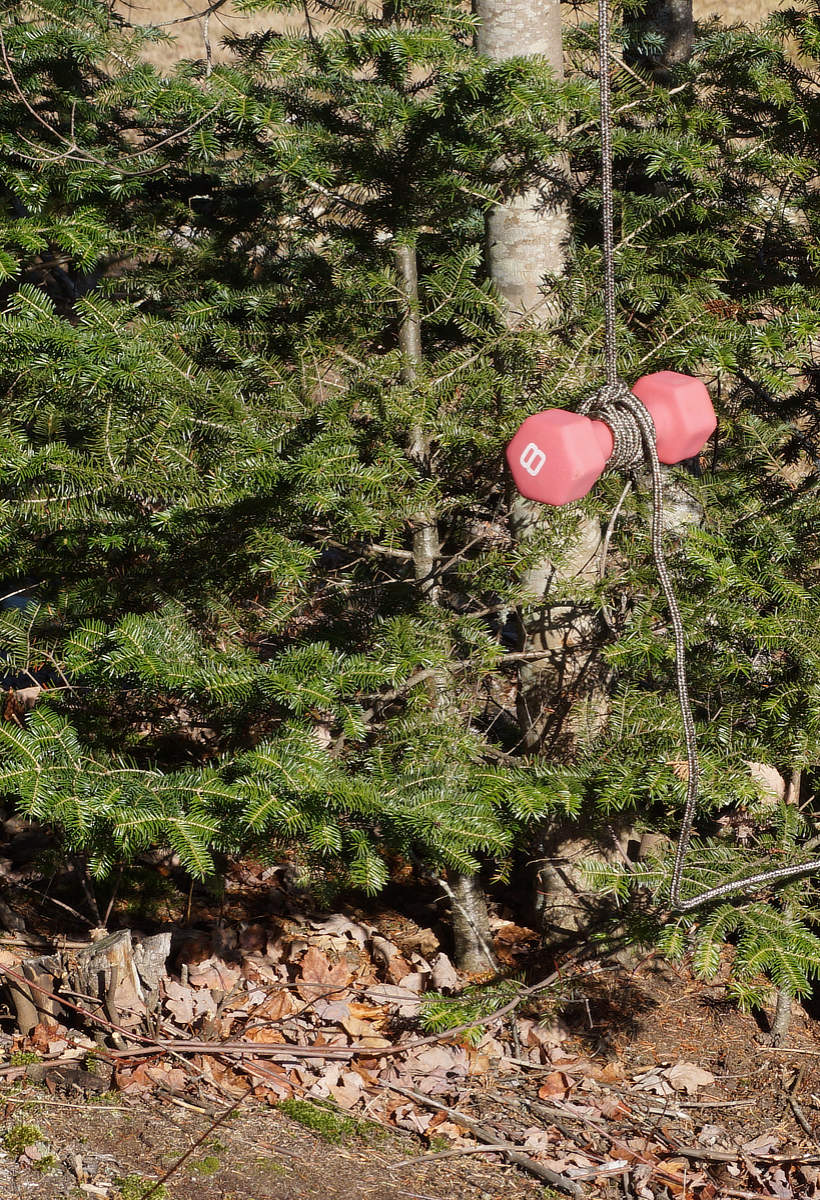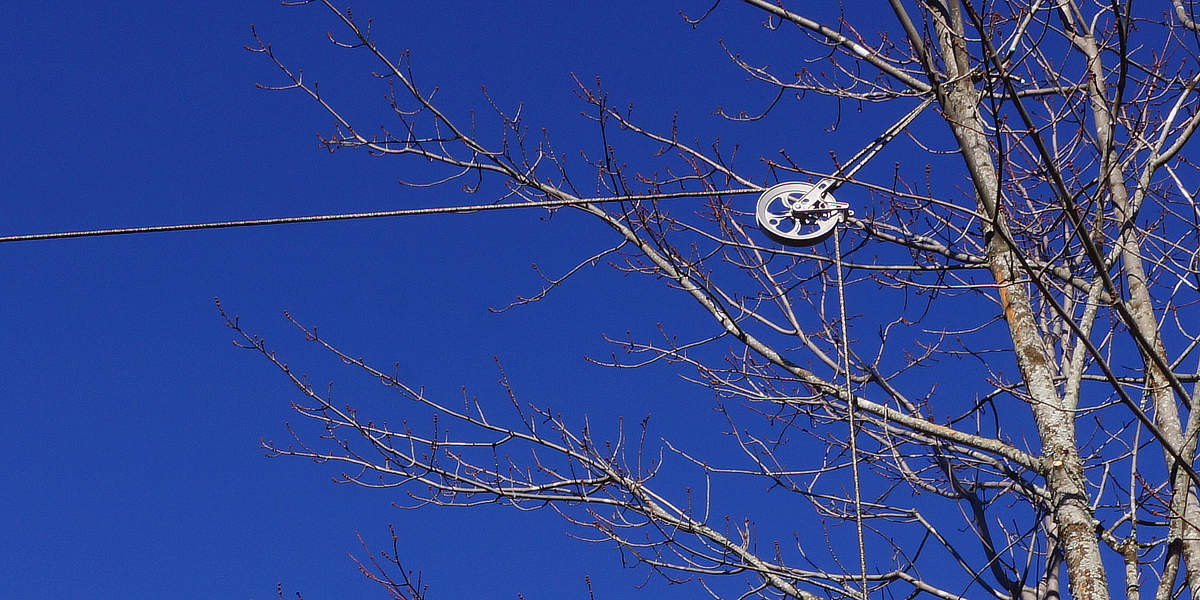Long Wire Antenna Attached To Tree With Pulley & Counterweight
Here’s a tip for any radio operators out there. Installing a long wire antenna when the only best way is to attach one end to a tree? (Example: House to Tree) Well, here’s what I did to help mitigate the problem of swaying trees in the wind – which would otherwise likely snap your antenna wire.
Use a pulley attached to the tree, with a counterweight.
I recently did this with a 130-foot end-fed HF long wire antenna.
The end of the long wire antenna near the house is attached (fixed). I just so happened to have a Maple tree about 140 feet away, making for the most convenient point to attach the other end of the antenna.
I knew that the wind and resulting tree sway would be a problem. To solve that problem is really pretty simple. Rope, Pulley, Counterweight. I bought a clothesline pulley (the good one, not the cheap plastic), and I already had plenty of various size rope. I ended up using one of Mrs. J’s weights (8 pound) as the counterpoise to counterbalance everything.
The antenna happens to be a EFHW-8010-1K (no affiliation). They recommend, “Always make sure that any installation involving moving trees has enough sag and not too much counterweight if a pulley system is used otherwise the flex in a swaying tree limb may snap your wire!”
The antenna wire is 16AWG, and has a tensile strength of ~85 pounds according to the manufacturer.
I put up an extension ladder into the Maple tree. At first, I used paracord for the tree attachment and antenna wire attachment (via an insulator separating the antenna from the paracord). However, this presented a problem… The diameter of the paracord. Although plenty strong enough, I felt that it could potentially slip off the clothesline pulley and get jammed up. So instead, I chose a larger diameter rope. It’s big enough not to pop off the pulley and get jammed (in theory).
Clothesline Pulley

I chose the following pulley. Heavy duty, rust-proof, ball-bearings, and (believe it or not, made in America).
Strata Ball Bearing Style, Heavy Duty
(view on amzn)
Assuming this setup survives the upcoming winter, I’m going to do a better job of protecting the tree – come spring. Because the tree will eventually grow around the rope. I know there are solutions to this in the landscape /arborist genre.
Counterpoise – Counterweight
I took the easy way out. Stole one of Mrs. J’s barbell weights. Actually, it’s temporary. I wasn’t sure how much counterweight to attach to the rope via the pulley and antenna. I experimented.
Like I said, this long wire antenna is 130 feet long. After having attached the metal clothesline pulley to the tree, I fed rope through the pulley, and then tied it to the antenna end insulator.
Several of Mrs. J’s barbell weights were at my feet at the base of the tree. I pulled on the rope and hoisted up the antenna, leaving a good bit of sag in the middle. Then, started with a 3 pound weight. Not enough. Next, a 5 pound weight. Not bad, but sagging a good bit. Lastly, the 8 pound weight. This seemed pretty good, leaving only some sag over the entire span, but not a whole lot (looks like less than 2 feet). The tensile strength of the antenna wire is supposedly ~85 pounds. So in theory, there’s plenty of margin (10:1). That is, so long as the pulley and rope don’t freeze up solid during the winter up here in northern New Hampshire! Like I said, this is an experiment.

It was windy the other day. I went over to the tree to watch the pulley and counterweight do its job. It was perfect, observing the counterweight moving gently up and down with some of the wind gusts. If I stay with the 8 pound counterweight, I will probably make my own. Fill 8lbs QUIKRETE concrete into a coffee can and sink an eyebolt into the top (for example). Then I can give the 8 pound barbell back to Mrs. J (grin).
This is all pretty common sense, but I thought I would share a few photos of my project the other day.
[ Read: Lightning Protection For HF/UHF/VHF Antennas ]
[ Read: Shortwave and Ham Radio Bands ]


Looks good Ken,
Comms will be very important. “Ya don’t know what you’ve got til it’s gone.” Ought to be a song.
I encourage you to make your quick – crete weight soon. Those gals can be cranky if ya mess with their stuff.
An interesting week.
Sash weights work good for this. Don’t make the weights too heavy! Otherwise the wire will stretch over time. At best it’ll detune the antenna. At worst it’ll BREAK the antenna. There should be a little sag in the antenna. If there isn’t any, the weight is too heavy. If you have one of those handheld spring scales, the ones with the eye at the top of it and a hook at the bottom, you can increase or decrease the pull using the scale, and it’ll indicate the weight you need.
In a pinch, or for temporary portable work where weight is an issue, single or ganged bungee cords will work.
Good advice, thanks. This was a decision that I was unsure of. How much weight to use versus wire sag. I don’t want to stretch out the wire over time with too much weight either. Eyeballed it at maybe 2′ sag at 8 pounds over the span. There’s probably some complicated formula to use to determine this (wire type & AWG versus tensile strength and/or stretch).
There probably is a formula. There was when I was stringing telephone cables, but that was knowing exactly what the cables or messenger strands were made of. That was also at a time when I could remember such things! Ham radio antennas can be made of almost any conductive alloy, and some are more prone to elongating than others. Hard-drawn copper is best for antennas when they’re being stretched out, but I know soft-drawn electrical wiring is often used; often wire that’s meant for installation in a conduit, and not meant to be pulled taut. The softer the wire is, the more sag you need, as it’s more prone to elongation. If you’re worried about it stretching out, you can use a messenger strand of UV resistant parachute cord, ty-wrapping the wire to it at intervals. That way the strain is placed on the messenger strand and not the wire. In the lifeboats on my old ship there was a 500Khz, hand-cranked radio called a Gibson Girl. You worked the crank and the radio sent out the ship’s name in Morse code in the hopes rescuers would home in on it. The antenna was of really delicate, lightweight braided copper, but it was wrapped around a tough nylon cord. It was held aloft with either a large box kite or a hydrogen-filled weather balloon, so it had to be able to take a hell of a strain, and yet it was wound up and stored in a container not much bigger than a snuff can!
Half the intrigue of ham radio is working with what you’ve got, where you are, when you are, and still getting your signal out there!
In my area anything tied to a tree is asking to be lightning struck. Years ago before low cost satellite tv was available someone started a business where a yagi antenna was put in a pine top pointing to a broadcast tower. After one summer of operation it closed down after many house fires traced back to lightning strikes from a conductor in a tree top. It was pretty obvious from the tree, ground, and area of damage after the strike.
I don’t mean to throw cold water on your idea at all. This is a good idea in theory but maybe a large physical disconnect unless in actual use and disconnected otherwise. ymmv.
Lightning protection is always recommended, regardless of one’s location (though some parts of the country are certainly much more susceptible!).
PL259 Inline Lightning Arrestor
Antennas are always going to be lightning fodder. Ground you antennas when they’re not being used. Don’t just disconnect them from the radio. That lightning bolt has traveled across miles of high resistance air. If it hits your antenna and travels down the coax to the end, it’s going to continue its trip to ground through whatever’s around it! That one or two foot gap between the coax connector and your radio is going to be NOTHING to that much juice!!! And if that path goes through wood or some other flammable material to find ground through, say, the wiring in a nearby wall, you’re going to probably end up with a structure fire!
Yes, I have researched NVIS to an extent. Thanks for the link. I downloaded the PDF for reference.
Thank you for taking the time to describe your experiences. While I’m aware of the pulley method for securing a wire antenna to a tree, there’s nothing better than other hams’ nuts & bolts adventures to give me specific ideas.
One question: the pulley you chose is high quality and non-rusting, and I assume your rope is UV resistant, but what about the paracord? Is there a specific type of UV resistant ham- preferred type?
Hi Ken, instead of a coffee can with an eye bolt you might consider using a piece of 3″ PVC filed with Quikrete and eye bolt, inside and a 4″ X10`PVC pipe. This should stop the wind from swinging the weight.
Just so happens I have a long wire antenna sitting in a box in the radio room. Been brainstorming how I wanted to mount it and where. Your pulley arrangement might work for me. Thanks
Glad that this provoked an idea for you. My long wire setup is still in excellent condition, even after several recent very windy periods. And I do believe that it’s worth buying that metal pulley with ball-bearings. It has a nice and smooth operation.
I use this method also in the trees.
Have one end fed HF with with a weight and two folded dipoles with weights on each end,
center feed support with a pully screwed into tree.
I have had ice buildup lift the weights up a couple of times.
These antennas are for standby and general SWLing.
My primary HF antennas are two multi band verticals.